oil CHEVROLET EXPRESS 1997 1.G Owner's Manual
[x] Cancel search | Manufacturer: CHEVROLET, Model Year: 1997, Model line: EXPRESS, Model: CHEVROLET EXPRESS 1997 1.GPages: 386, PDF Size: 20.32 MB
Page 251 of 386
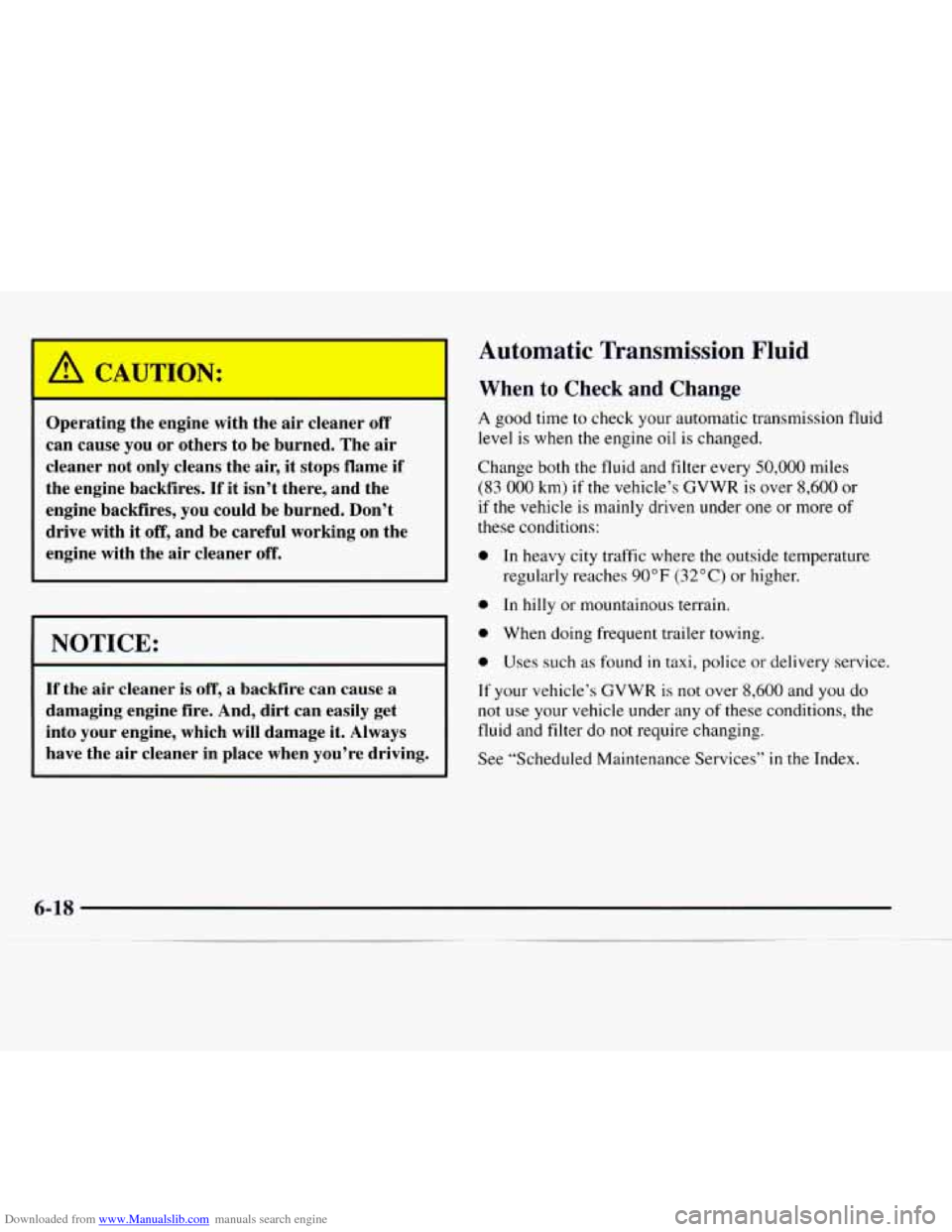
Downloaded from www.Manualslib.com manuals search engine Operating the engine with the air cleaner off
can cause you or others to be burned. The air
cleaner not only cleans the air,
it stops flame if
the engine backfires. If it isn’t there, and the
engine backfires, you could be burned. Don’t
drive with it
off, and be careful working on the
engine with the air cleaner off.
NOTICE:
If the air cleaner is off, a backfire can cause a
damaging engine fire. And, dirt can easily get
into your engine, which will damage it. Always
have the
air cleaner in place when you’re driving.
Automatic Transmission Fluid
When to Check and Change
A good time to check your automatic transmission fluid
level is when the engine oil is changed.
Change both the fluid and filter every
50,000 miles
(83 000 km) if the vehicle’s GVWR is over 8,600 or
if the vehicle is mainly driven under one or more of
these conditions:
0 In heavy city traffic where the outside temperature
regularly reaches
90°F (32°C) or higher.
0 In hilly or mountainous terrain.
0 When doing frequent trailer towing.
0 Uses such as found in taxi, police or delivery service.
If your vehicle’s
GVWR is not over 8,600 and you do
not use your vehicle under any of these conditions, the
fluid and filter do not require changing.
See “Scheduled Maintenance Services”
in the Index.
Page 255 of 386
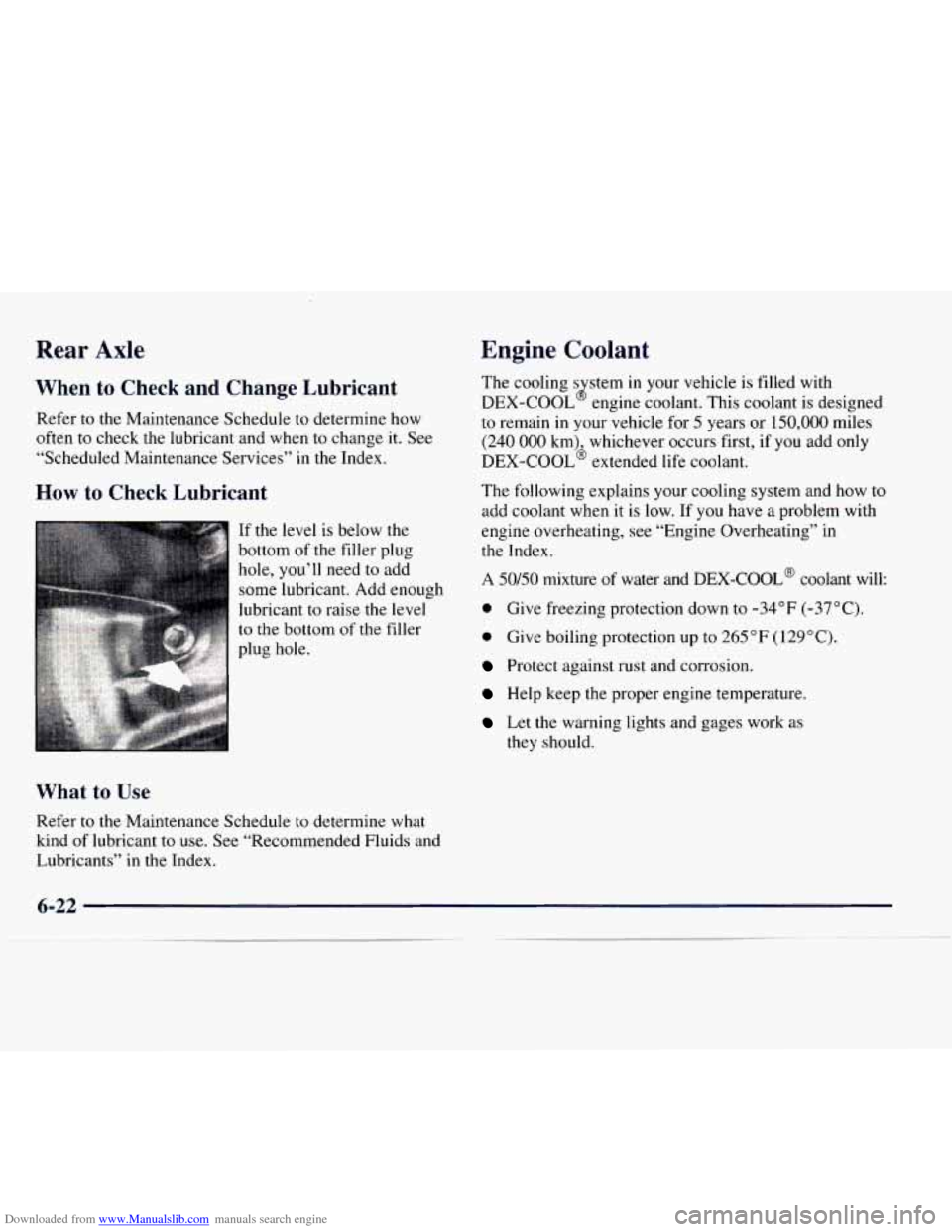
Downloaded from www.Manualslib.com manuals search engine Rear Axle Engine Coolant
When to Check and Change Lubricant
Refer to the Maintenance Schedule to determine how
often to check the lubricant and when to change it. See
“Scheduled Maintenance Services” in the Index.
How to Check Lubricant
What to
Use
Refer to the Maintenance Schedule to determine what
kind of lubricant to use. See “Recommended Fluids and
Lubricants”
in the Index. The cooling
s stem
in your vehicle is filled with
DEX-COOL
8 engine coolant. This coolant is designed
to remain in your vehicle for
5 years or 150,000 miles
(240
000 km) whichever occurs first, if you add only
DEX-COOL’ extended life coolant.
The following explains your cooling system
and how to
add coolant when it is low. If you have a problem with
engine overheating,
see “Engine Overheating” in
the Index.
A 50/50 mixture of water and DEX-COOL@ coolant will:
0 Give freezing protection down to -34°F (-37°C).
0 Give boiling protection up to 265 “F (129°C).
Protect against rust and corrosion.
Help keep the proper engine temperature.
Let the warning lights and gages work as
they should .
Page 256 of 386
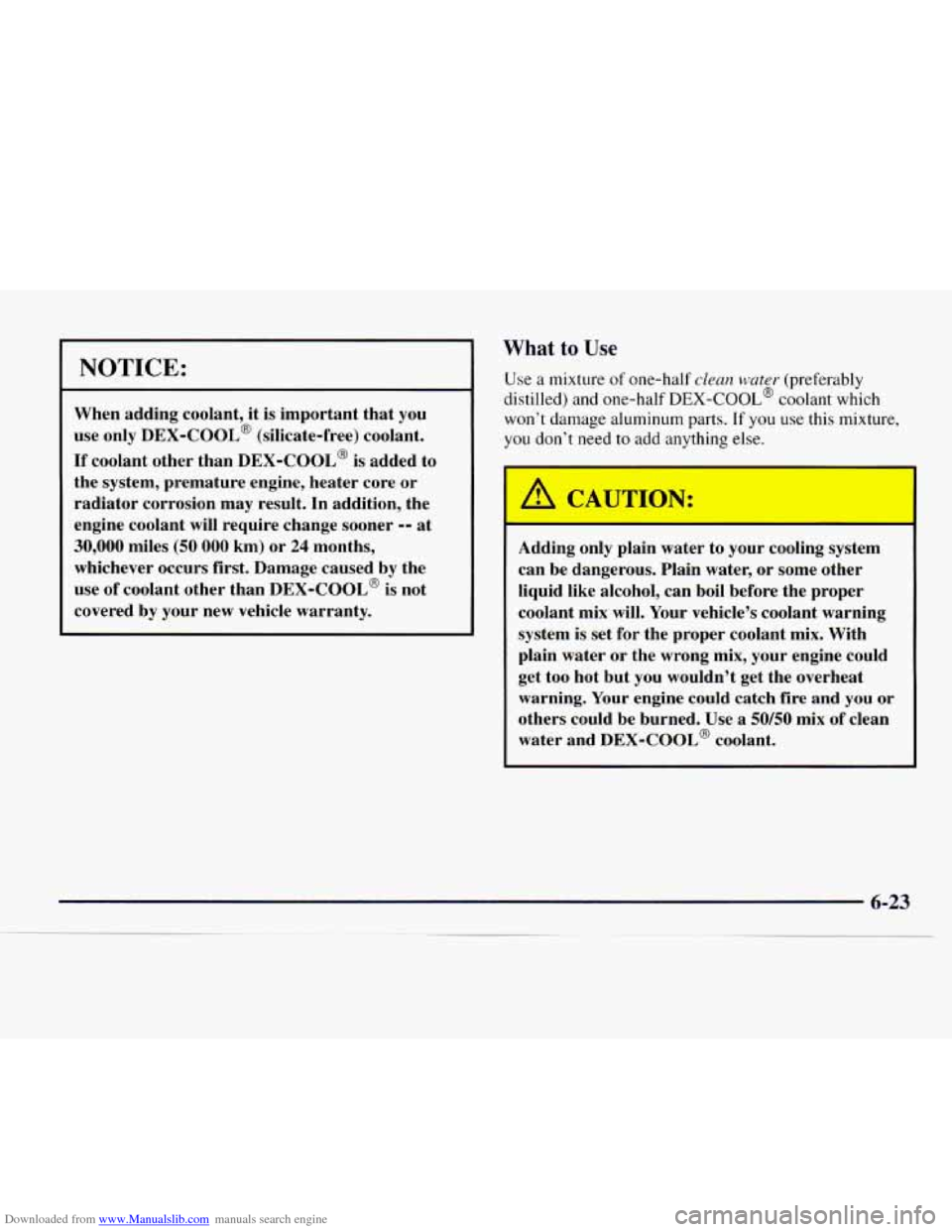
Downloaded from www.Manualslib.com manuals search engine NOTICE:
When adding coolant, it is important that you
use only
DEX-COOL@ (silicate-free) coolant.
If coolant other than DEX-COOL@ is added to
the system, premature engine, heater core or
radiator corrosion may result.
In addition, the
engine coolant will require change sooner
-- at
30,000 miles (50 000 km) or 24 months,
whichever occurs first. Damage caused by the
use of coolant other than DEX-COOL@ is not
covered by your new vehicle warranty.
What to Use
Use a mixture of one-half clean water (preferably
distilled) and one-half
DEX-COOL@ coolant which
won’t damage aluminum parts.
If you use this mixture,
you don’t need to add anything else.
I
I
Adding only plain water to your cooling system
can be dangerous. Plain water,
or some other
liquid like alcohol, can boil before the proper
coolant mix will. Your vehicle’s coolant warning
system is set for the proper coolant mix. With
plain water or the wrong mix, your engine could
get too hot but you wouldn’t get the overheat
warning. Your engine could catch fire and you or
others could be burned. Use a
50/50 mix of clean
water and DEX-COOL@ coolant.
Page 263 of 386
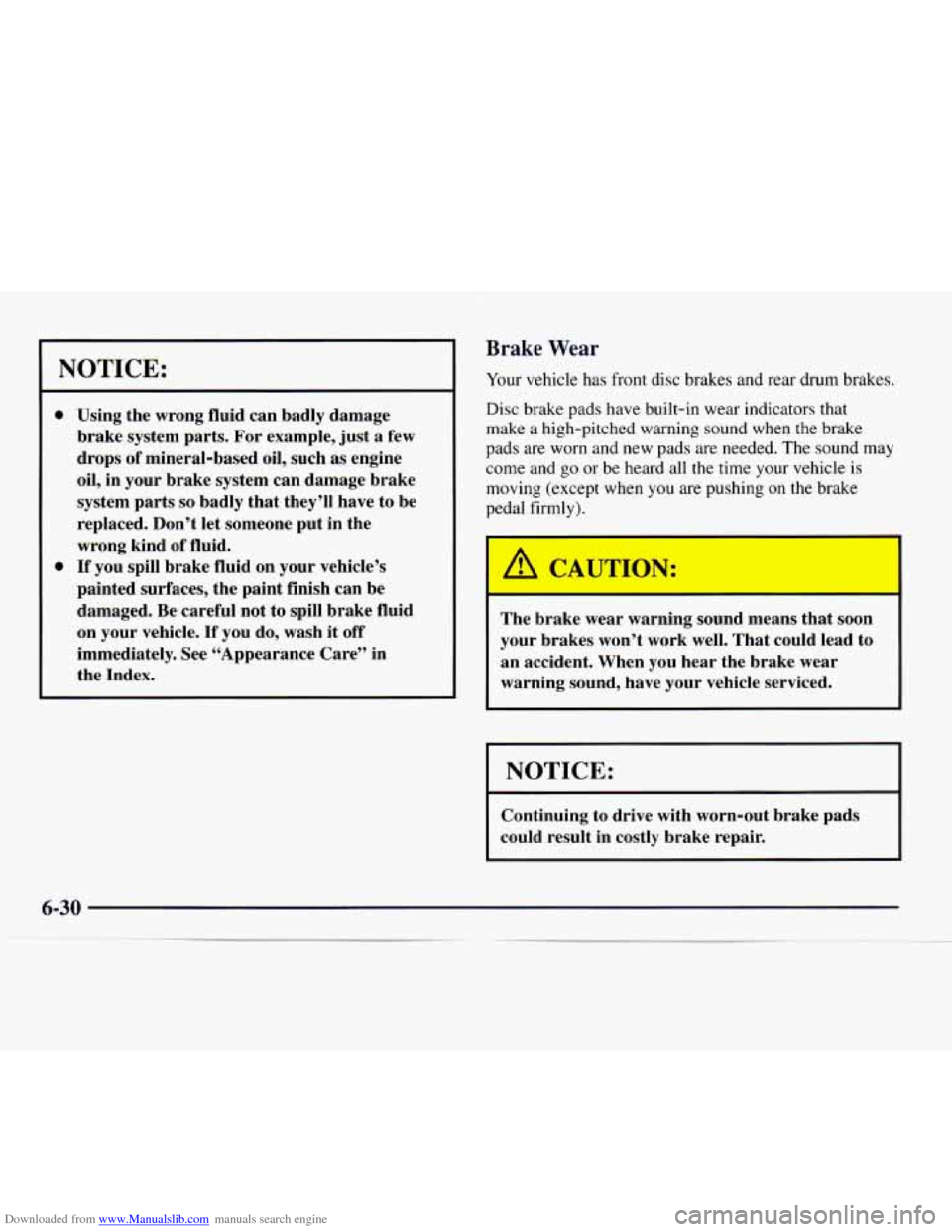
Downloaded from www.Manualslib.com manuals search engine NOTICE:
a
a
Using the wrong fluid can badly damage
brake system parts. For example, just
a few
drops
of mineral-based oil, such as engine
oil, in your brake system can damage brake
system parts
so badly that they’ll have to be
replaced. Don’t let someone put in the
wrong kind
of fluid.
If you spill brake fluid on your vehicle’s
painted surfaces, the paint finish can be
damaged.
Be careful not to spill brake fluid
on your vehicle.
If you do, wash it off
immediately. See “Appearance Care” in
the Index.
Brake Wear
Your vehicle has front disc brakes and rear drum brakes.
Disc brake pads have built-in wear indicators that
make a high-pitched warning sound when
the brake
pads are worn and new pads are needed. The sound may
come
and go or be heard all the time your vehicle is
moving (except when
you are pushing on the brake
pedal firmly).
A CAUTION:
The brake wear warning sound means that soon
your brakes won’t work well. That could lead to
an accident. When you hear the brake wear
warning sound, have your vehicle serviced.
NOTICE:
Continuing to drive with worn-out brake pads
could result in costly brake repair.
6-30
Page 284 of 386
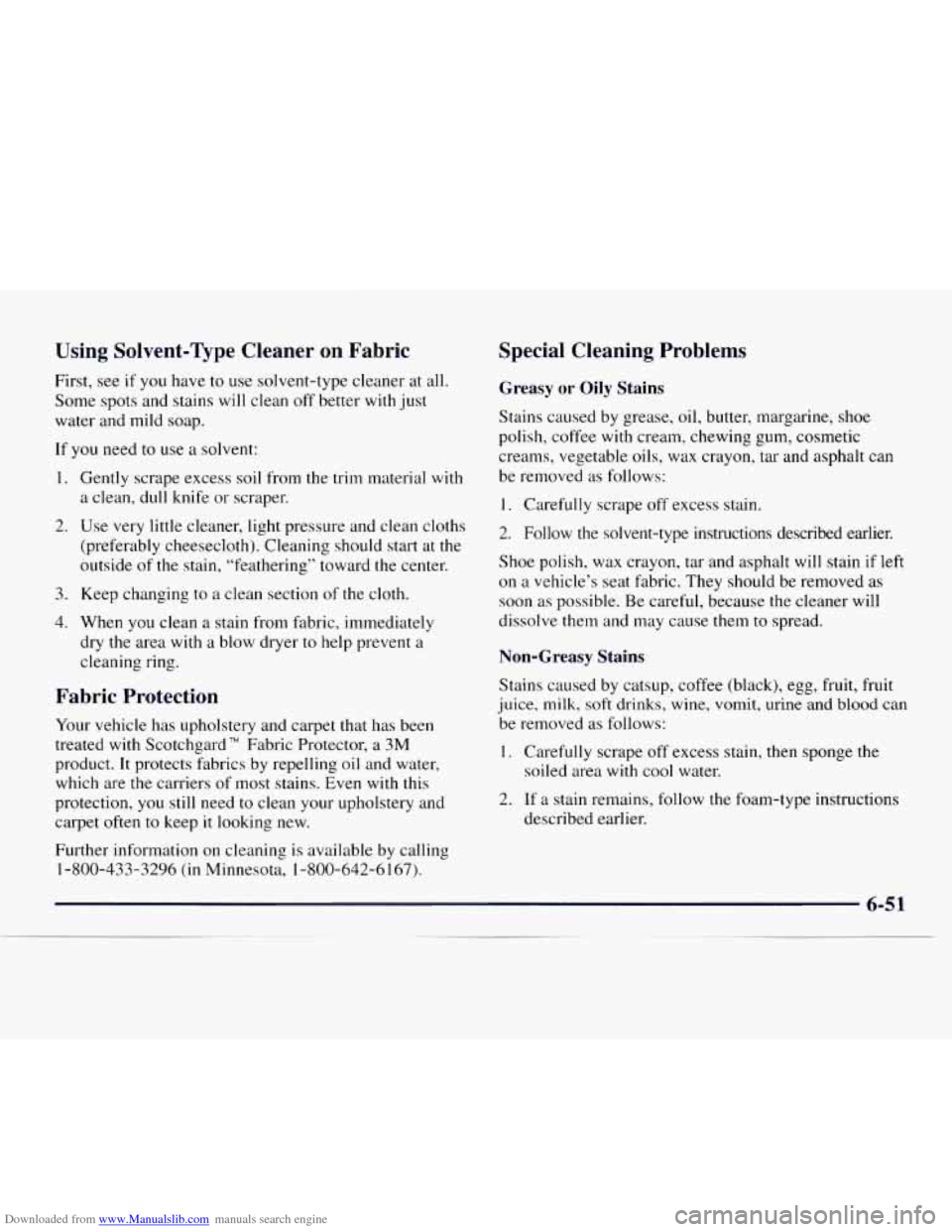
Downloaded from www.Manualslib.com manuals search engine Using Solvent-Type Cleaner on Fabric
First, see if you have to use solvent-type cleaner at all.
Some
spots and stains will clean off better with just
water and mild soap.
If
you need to use a solvent:
1. Gently scrape excess soil from the trim material with
a clean, dull knife or scraper.
2. Use very little cleaner, light pressure and clean cloths
(preferably cheesecloth). Cleaning should start at the
outside
of the stain, “feathering” toward the center.
3. Keep changing to
a clean section of the cloth.
4. When you clean a stain from fabric, immediately
dry the area with a blow dryer to help prevent a
cleaning ring.
Fabric Protection
Your vehicle has upholstery and carpet that has been
treated with Scotchgard
TM Fabric Protector, a 3M
product. It protects fabrics by repelling oil and water,
which are the carriers of most stains. Even with this
protection, you
still need to clean your upholstery and
carpet often to keep
it looking new.
Further information
on cleaning is available by calling
1-800-433-3296
(in Minnesota, 1-800-642-6 167).
Special Cleaning Problems
Greasy or Oily Stains
Stains caused by grease, oil, butter, margarine, shoe
polish, coffee with cream, chewing gum, cosmetic
creams, vegetable oils, wax crayon, tar and asphalt can
be removed as follows:
1. Carefully scrape off excess stain.
2. Follow the solvent-type instructions described earlier.
Shoe polish, wax crayon, tar and asphalt will stain if left
on a vehicle’s seat fabric. They should be removed as
soon as possible. Be careful, because the cleaner will
dissolve them and may cause them to spread.
Non-Greasy Stains
Stains caused by catsup, coffee (black), egg, fruit, fruit
juice, milk, soft drinks, wine, vomit, urine and
blood can
be removed as follows:
1. Carefully scrape off excess stain, then sponge the
soiled area with cool water.
2. If a stain remains, follow the foam-type instructions
described earlier.
Page 285 of 386
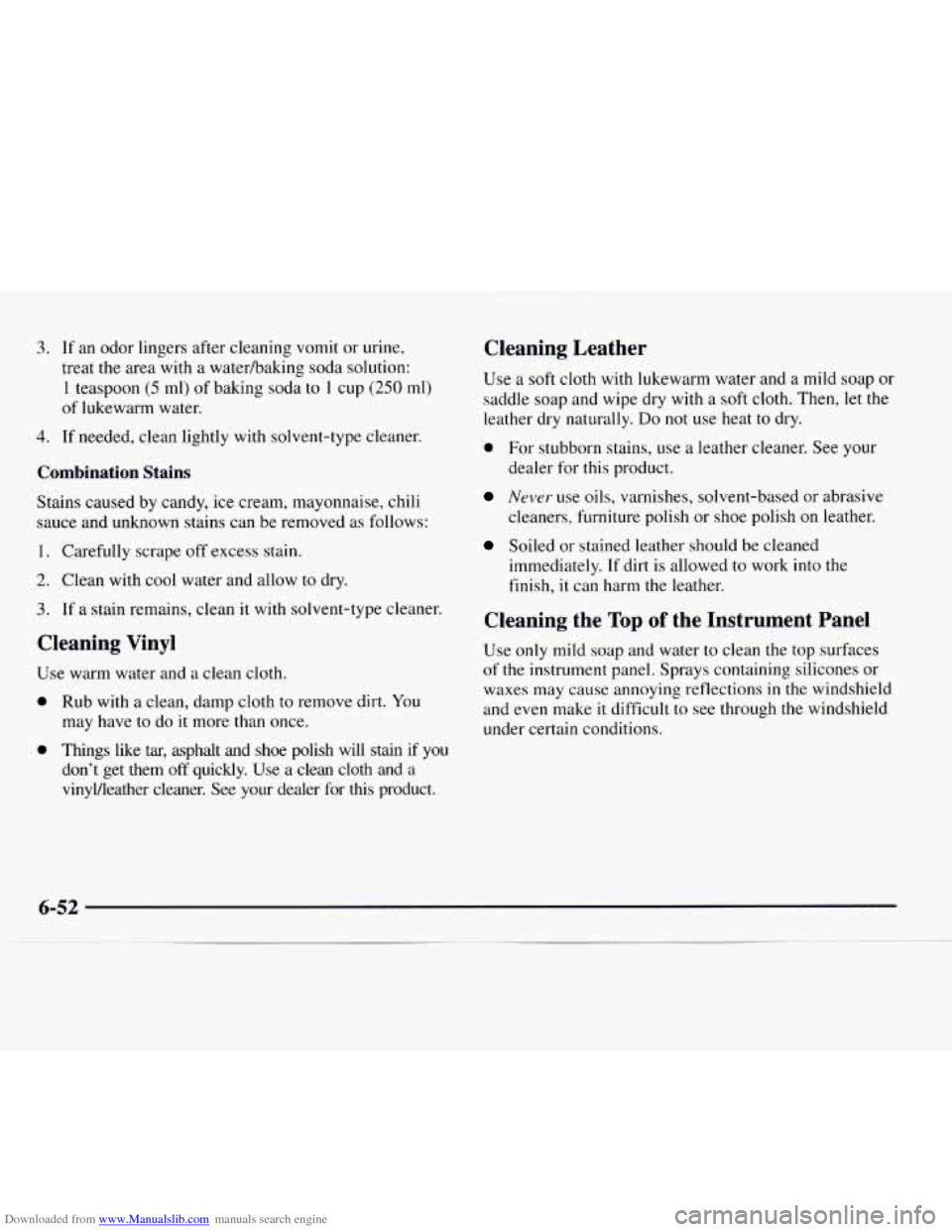
Downloaded from www.Manualslib.com manuals search engine 3. If an odor lingers after cleaning vomit or urine,
treat the area with
a waterhaking soda solution:
1 teaspoon (5 ml) of baking soda to I cup (250 ml)
of lukewarm water.
4. If needed, clean lightly with solvent-type cleaner.
Combination Stains
Stains caused by candy, ice cream, mayonnaise, chili
sauce and unknown stains can be removed
as follows:
1. Carefully scrape off excess stain.
2. Clean with cool water and allow to dry.
3. If a stain remains, clean it with solvent-type cleaner.
Cleaning Vinyl
use warm water and a clean cloth.
0 Rub with a clean, damp cloth to remove dirt. You
may have to do it more than once.
0 Things like tar, asphalt and shoe polish will stain if you
don’t get them
off quickly. Use a clean cloth and a
vinylheather cleaner. See your dealer for this product.
Cleaning Leather
Use a soft cloth with lukewarm water and a mild soap or
saddle soap and wipe dry with a soft cloth. Then, let the
leather dry naturally.
Do not use heat to dry.
0 For stubborn stains, use a leather cleaner. See your
dealer for this product.
Never use oils, varnishes, solvent-based or abrasive
cleaners, furniture polish or shoe polish on leather.
Soiled or stained leather should be cleaned
immediately.
If dirt is allowed to work into the
finish, it can harm the leather.
Cleaning the Top of the Instrument Panel
Use only mild soap and water to clean the top surfaces
of the instrument panel. Sprays containing silicones or
waxes may cause annoying reflections
in the windshield
and even make
it difficult to see through the windshield
under certain conditions.
Page 287 of 386
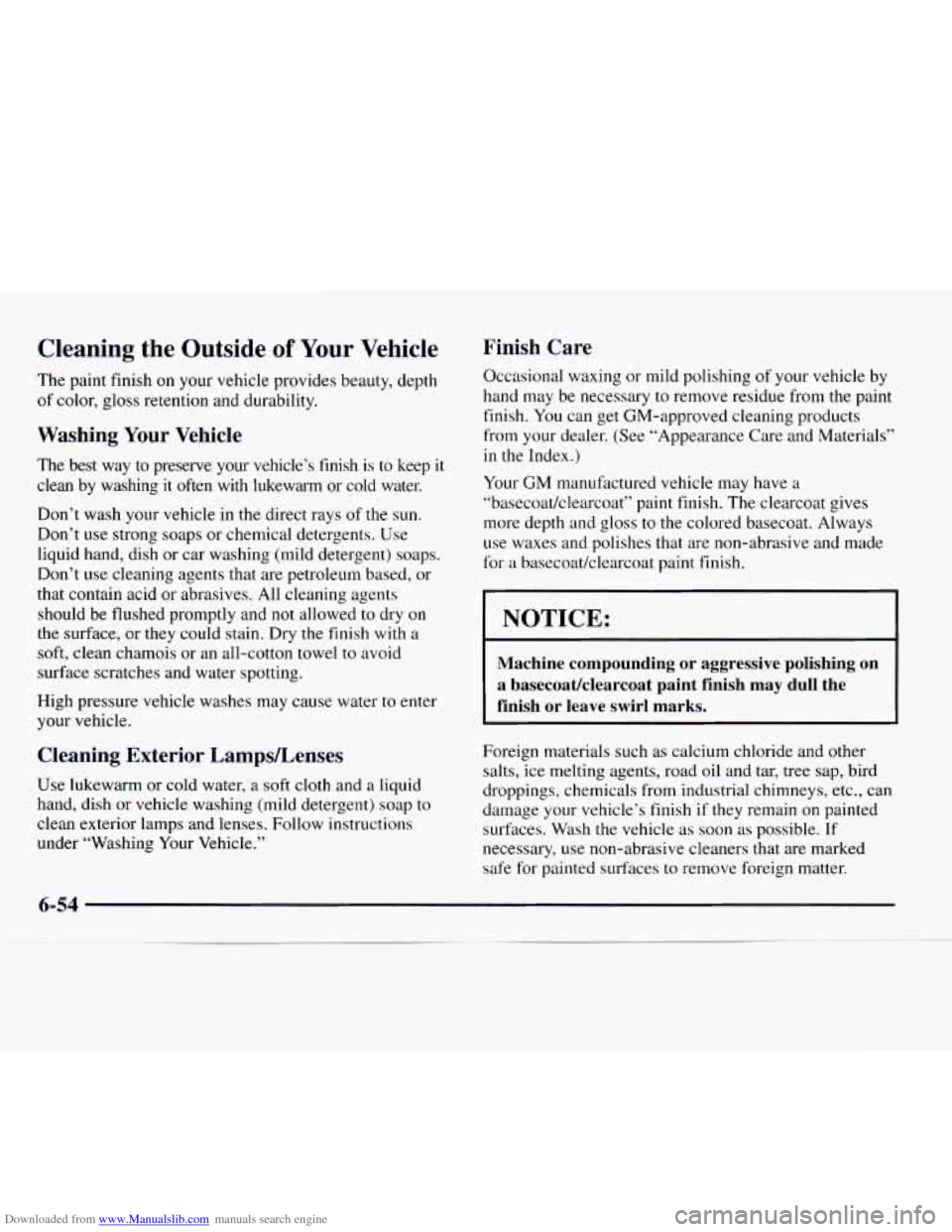
Downloaded from www.Manualslib.com manuals search engine Cleaning the Outside of Your Vehicle
The paint finish on your vehicle provides beauty, depth
of color,
gloss retention and durability.
Washing Your Vehicle
The best way to preserve your vehicle’s finish is to keep it
clean by washing it often with lukewam or cold water.
Don’t wash your vehicle in the direct rays of the sun.
Don’t use strong soaps or chemical detergents. Use
liquid hand, dish or car washing (mild detergent) soaps.
Don’t use cleaning agents that are petroleum based, or
that contain acid or abrasives. All cleaning agents
should be flushed promptly and
not allowed to dry on
the surface, or they could stain. Dry the finish with a
soft, clean chamois or an all-cotton towel to avoid
surface scratches and water spotting.
High pressure vehicle washes may cause water to enter
your vehicle.
Cleaning Exterior LampsLenses
Use lukewarm or cold water, a soft cloth and a liquid
hand, dish
or vehicle washing (mild detergent) soap to
clean exterior lamps and lenses. Follow instructions
under “Washing Your Vehicle.”
Finish Care
Occasional waxing or mild polishing of your vehicle by
hand may be necessary
to remove residue from the paint
finish.
You can get GM-approved cleaning products
from your dealer. (See “Appearance Care and Materials”
in the Index.)
Your GM manufactured vehicle may have
a
“basecoat/clearcoat” paint finish. The clearcoat gives
more depth and gloss
to the colored basecoat. Always
use waxes and polishes that are non-abrasive and made
for
a basecoat/clearcoat paint finish.
I NOTICE:
Machine compounding or aggressive polishing on
a basecoat/clearcoat paint finish
may dull the
finish or leave swirl marks.
1
Foreign materials such as calcium chloride and other
salts, ice melting agents, road oil and tar, tree sap, bird
droppings, chemicals from industrial chimneys, etc., can
damage your vehicle’s finish if they remain
on painted
surfaces. Wash
the vehicle as soon as possible. If
necessary, use non-abrasive cleaners that are marked
safe for painted surfaces to remove foreign matter.
Page 290 of 386
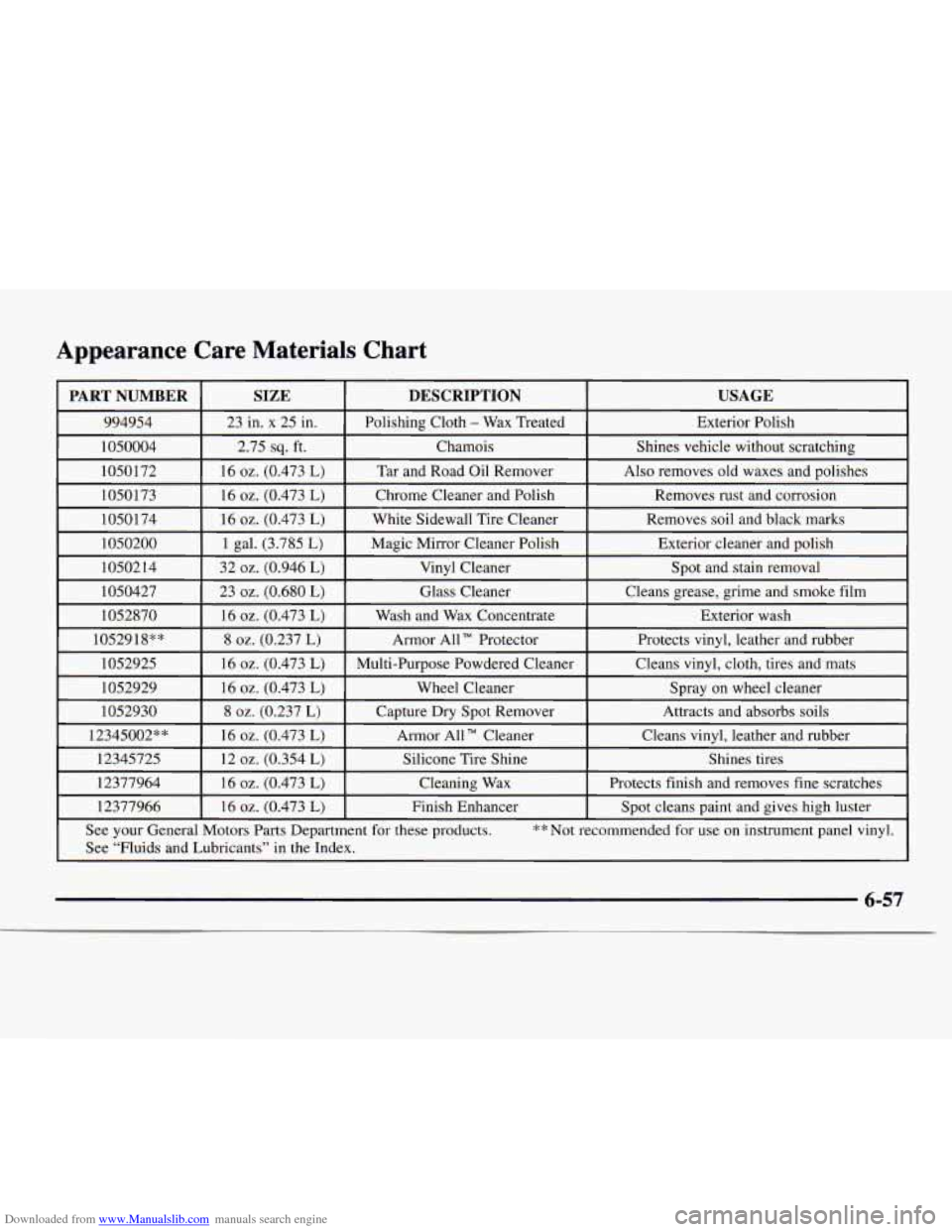
Downloaded from www.Manualslib.com manuals search engine Appearance Care Materials Chart
PART NUMBER DESCRIPTION USAGE
1052929
Cleans vinyl, leather and rubber
Armor All
TM Cleaner
16 oz. (0.473 L) 12345002”” Attracts and
absorbs soils Capture
Dry Spot Remover
8 oz. (0.237 L)
1052930 Spray on wheel
cleaner
Wheel Cleaner 16
oz. (0.473 L)
12345725 Spot cleans paint and gives high luster Finish
Enhancer 16
oz. (0.473 L) 12377966 Protects finish
and removes fine scratches
Cleaning Wax
16
oz. (0.473 L)
12377964 Shines tires Silicone
Tire Shine
12
oz. (0.354 L)
See your General Motors Parts Department for these products.
** Not recommended for use on instrument panel vinyl.
See “Fluids and Lubricants” in the Index.
6-57
Page 297 of 386
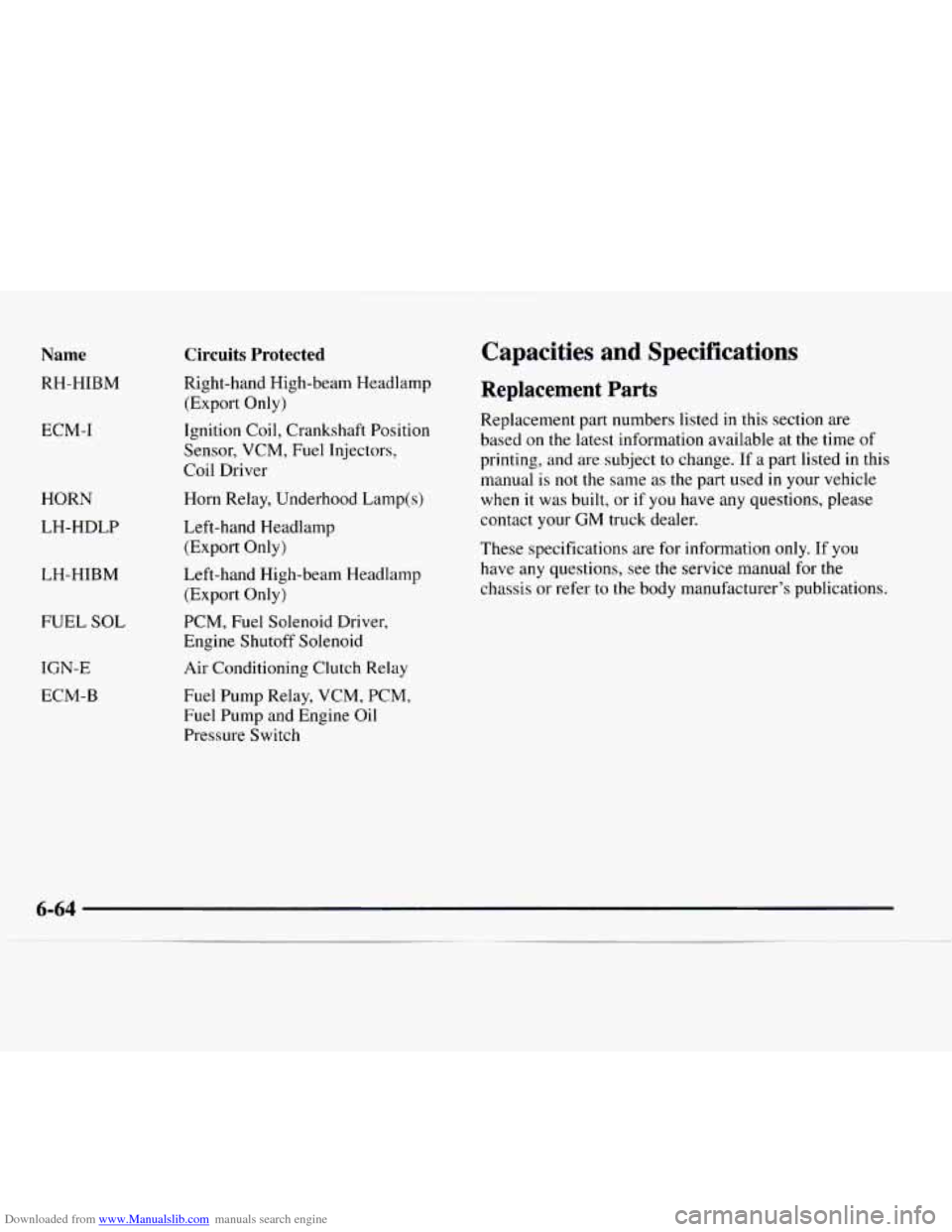
Downloaded from www.Manualslib.com manuals search engine Name
RH-HIBM
ECM-I
HORN LH-HDLP
LH-HIBM
FUEL SOL
IGN-E
ECM-B
Circuits Protected
Right-hand High-beam Headlamp (Export Only)
Ignition Coil, Crankshaft Position
Sensor, VCM, Fuel Injectors,
Coil Driver
Horn Relay, Underhood Lamp(
s)
Left-hand Headlamp
(Export Only)
Left-hand High-beam Headlamp (Export Only)
PCM,
Fuel Solenoid Driver,
Engine Shutoff Solenoid
Air Conditioning Clutch Relay
Fuel Pump Relay, VCM, PCM,
Fuel Pump and Engine Oil
Pressure Switch
Capacities and Specifications
Replacement Parts
Replacement part numbers listed in this section are
based on the latest information available at the time
of
printing, and are subject to change. If a part listed in this
manual
is not the same as the part used in your vehicle
when
it was built, or if you have any questions, please
contact your
GM truck dealer.
These specifications are for information only. If you
have any questions, see the service manual for the
chassis
or refer to the body manufacturer’s publications.
Page 299 of 386
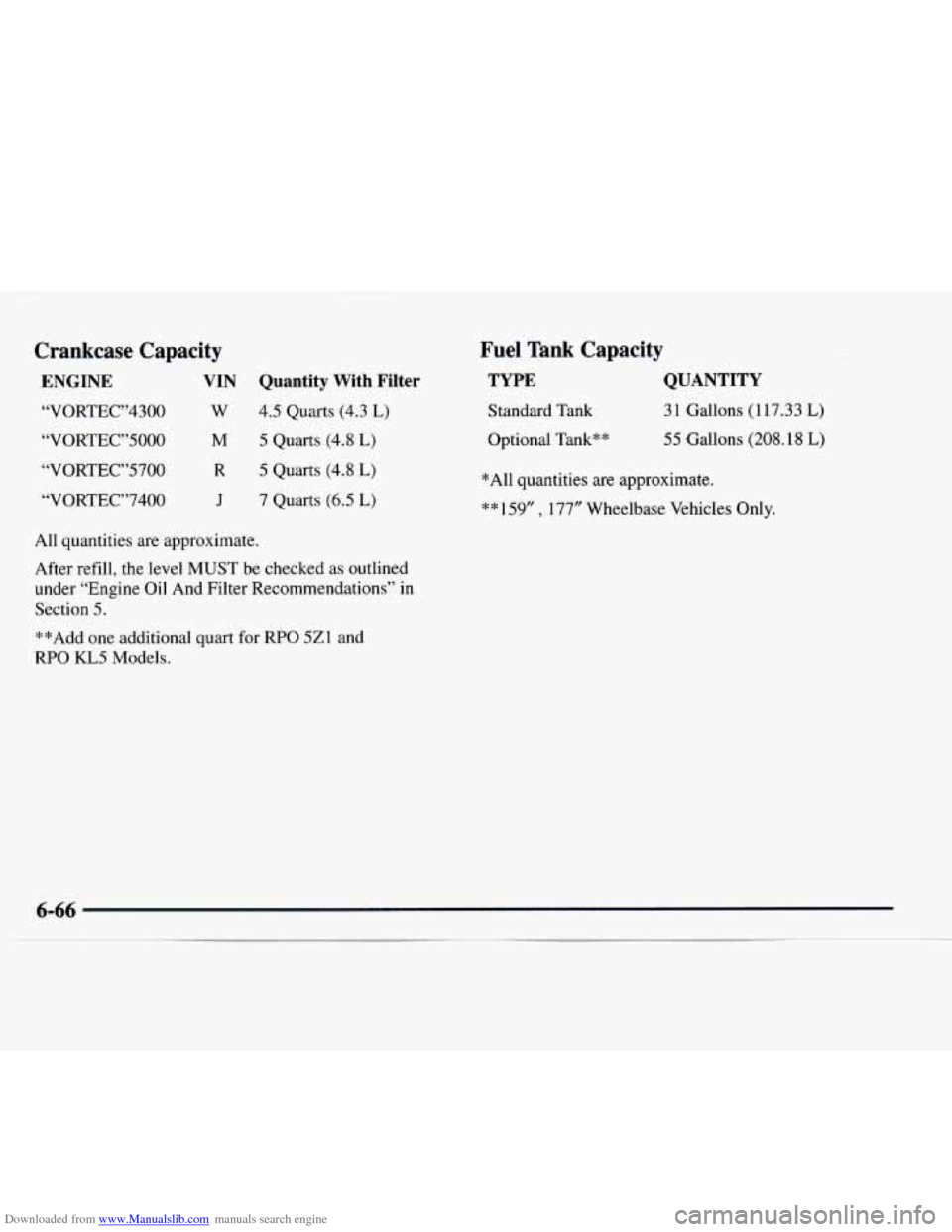
Downloaded from www.Manualslib.com manuals search engine Crankcase Capacity
ENGINE VIN Quantity With Filter
“VORTEC”4300 W 4.5 Quarts (4.3 L)
“VORTEC”5000 M 5 Quarts (4.8 L)
“VORTEC”5700 R 5 Quarts (4.8 L)
“VORTEC”7400 J 7 Quarts (6.5 L)
All quantities are approximate.
After refill, the level
MUST be checked as outlined
under “Engine Oil And Filter Recommendations”
in
Section 5.
**Add one additional quart for RPO 5Zl and
RPO KL5 Models.
Fuel Tank Capacity
TYPE QUANTITY
Standard Tank 31 Gallons (117.33 L)
Optional Tank** 55 Gallons (208.18 L)
*All quantities are approximate.
** 159” , 177” Wheelbase Vehicles Only.